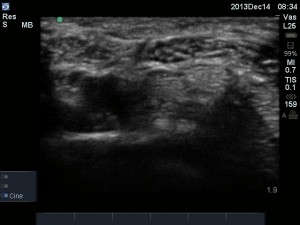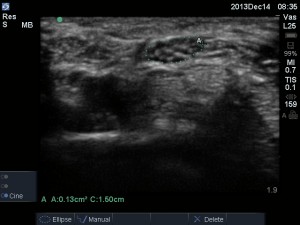Carpal tunnel syndrome
There are quite a number of studies looking at the use of ultrasound to diagnose carpal tunnel syndrome (CTS). The median nerve swells just proximal to the carpal tunnel in patients with CTS. The thought is that one can measure the size of the nerve to make the diagnosis. A recent article was published in the November 2013 edition of the Journal of Ultrasound in Medicine. The pub med link for this article by Tajika et al is http://www.ncbi.nlm.nih.gov/pubmed/24154903.
Here is the EDEfied summary…
There were 50 wrists from patients known to have carpal tunnel syndrome (34 patients, 25 women, mean age 59.5) and 81 wrists from healthy volunteers (45 people, 32 women, mean age 57.6). The diagnosis of CTS was made based on clinical symptoms, at least one positive provocative of test (e.g. Tinel, Phalen, etc), and a positive EMG. They measured the cross-sectional area of the median nerve at the level of the proximal inlet of the carpal tunnel and the distal radioulnar joint. Lo and behold, the median nerve was significantly larger proximally in patients with CTS. The mean area was 13.9 mm² proximally and 7.7 mm² distally. In contrast, in healthy volunteers, the mean area was 8.0 mm² proximally and 7.8 mm² distally. The most interesting results come from table 2. They performed an ROC analysis to sort out the best cutoff for making the diagnosis of CTS. The cross-sectional area of 10 mm² or more yielded a sensitivity of 98% for the diagnosis of CTS and an NPV of 99%. The specificity was only 83%. When they looked at the change in cross-sectional area from proximal to distal, the best cut off seemed to be a 2 mm² difference. With that cutoff, the sensitivity and NPV were 100%, with a specificity of 99%. Of course, it would be ideal if these numbers were generated from an undifferentiated population who were referred for testing for possible CTS. Nonetheless, these are interesting results.
See the images for an example of an enlarged median nerve in a patient that I recently saw. Both images are the same, with the second one showing the measurement of the cross-sectional area. Click on the images to make them bigger.
Steve









Thanks for the interesing article. Also thanks for pointing out the elliptical function. I didn’t even know our machine could do that. (The GE rep. told me how to use it).